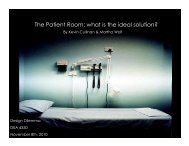The role of physical design and informal communication
The role of physical design and informal communication
The role of physical design and informal communication
You also want an ePaper? Increase the reach of your titles
YUMPU automatically turns print PDFs into web optimized ePapers that Google loves.
information that otherwise wouldn’t have been gathered from the other four methods<br />
<strong>of</strong> data collection. Five interviews were conducted with four different staff members<br />
on various occasions throughout the study. Interview guides were developed to focus<br />
the discussion, however probes were used <strong>and</strong> new questions added depending on the<br />
course <strong>of</strong> the interview (See appendix L). Consent was received from all to audio-<br />
record the interviews. This allowed the researcher to focus on what the nurse was<br />
saying rather than try to transcribe the entire discussion.<br />
<strong>The</strong> first interview was with the graduate nurse regarding her history as a<br />
nurses’ aide on 6N prior to her <strong>role</strong> as an RN. We believed the graduate nurse’s<br />
familiarity with the unit was a unique situation that could affect her orientation<br />
experience in a different way than someone who has never seen the unit before.<br />
<strong>The</strong> second interview was with the unit’s nurse manager. Here the goal was to<br />
underst<strong>and</strong> the organizational policies, norms, procedures, hierarchies <strong>and</strong> staffing<br />
patterns that affect the daily operations <strong>of</strong> the unit. In addition we sought to uncover<br />
any unique challenges faced by staff on 6N.<br />
<strong>The</strong> third interview was with a nurse practitioner who worked on four different<br />
units at the hospital, including 6N. This interview was valuable in that the interviewee<br />
was able to provide a unique comparative assessment <strong>of</strong> the unit, commenting on how<br />
6N differs from <strong>and</strong> is similar to other units.<br />
<strong>The</strong> fourth <strong>and</strong> fifth interviews were with the Orientor <strong>and</strong> graduate nurse,<br />
respectively. In both cases, the goal was to dig deeper into their perceptions <strong>of</strong> the<br />
impact that the unit’s <strong>physical</strong> layout has on opportunities for <strong>informal</strong> learning <strong>and</strong><br />
<strong>communication</strong> <strong>and</strong> stress. Additionally, more specific information on the graduate<br />
nurse orientation process <strong>and</strong> experience was sought. <strong>The</strong>se interviews were the most<br />
comprehensive <strong>and</strong> in-depth <strong>of</strong> them all.<br />
41







